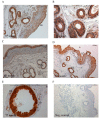TRPV6 and Calbindin-D9k-expression and localization in the bovine uterus and placenta during pregnancy
- PMID: 22931437
- PMCID: PMC3489777
- DOI: 10.1186/1477-7827-10-66
TRPV6 and Calbindin-D9k-expression and localization in the bovine uterus and placenta during pregnancy
Abstract
Background: Transient receptor potential channel type 6 (TRPV6) and Calbindin-D9k (CaBP-9k) are involved in the active calcium (Ca2+) transport mechanism in many tissues including placenta and uterus, suggesting a role in the establishment and maintenance of pregnancy. Moreover, TRPV6 and CaBP-9k seem to support the materno-fetal Ca2+ transport that is crucial for fetal Ca2+ homeostasis, bone growth and development. However, it is unknown if these proteins are also involved in the aetiology of pathologies associated with parturition in cows, such as retained fetal membranes (RFM). The aim of the current study was to create an expression profile of uterine and placentomal TRPV6 and CaBP-9k mRNAs and proteins during pregnancy and postpartum in cows with and without fetal membrane release.
Methods: Uteri and placentomes of 27 cows in different stages of pregnancy and placentomes of cows with and without RFM were collected. Protein and mRNA expression of TRPV6 and CaBP-9k was investigated by real-time PCR, immunohistochemistry and Western blot.
Results: In the uterine endometrium, highest TRPV6 and CaBP-9k expression was found in the last trimester of pregnancy, with a particular increase of protein in the glandular epithelium. In the placentomes, a gradual increase in TRPV6 mRNA was detectable towards parturition, while protein expression did not change significantly. Placentomal CaBP-9k expression did not change significantly throughout pregnancy but immunohistochemistry revealed an increase in staining intensity in the maternal crypt epithelium. Immunohistochemical, stronger placental CaBP-9k signals were seen in animals with RFM compared to animals with an undisturbed fetal membrane release, while protein levels, measured by Western blot analyses did not change significantly.
Conclusions: The results of the present study demonstrate a dynamic expression of TRPV6 and CaBP-9k during pregnancy in the bovine uterine endometrium and placentomes, suggesting a functional role for these proteins in Ca2+ metabolism during pregnancy. The temporal and spatial expression patterns indicate that TRPV6 and CaBP-9k may be involved in materno-fetal Ca2+ transport, mainly through an interplacentomal transport, and that both proteins may participate in physiological processes that are crucial for fetal and placental development. However, neither TRPV6 nor CaBP-9k seem to be causative in the retention of fetal membranes.
Figures











Similar articles
-
Calbindin-D9k gene expression during pregnancy and lactation in the rat.Mol Cell Endocrinol. 1992 Oct;88(1-3):119-28. doi: 10.1016/0303-7207(92)90016-y. Mol Cell Endocrinol. 1992. PMID: 1459335
-
Maternal-fetal transfer of endocrine disruptors in the induction of Calbindin-D9k mRNA and protein during pregnancy in rat model.Mol Cell Endocrinol. 2003 Dec 30;212(1-2):63-72. doi: 10.1016/j.mce.2003.08.011. Mol Cell Endocrinol. 2003. PMID: 14654251
-
Calcium transport genes are differently regulated in maternal and fetal placenta in the knockout mice of calbindin-D(9k) and -D(28k).Mol Reprod Dev. 2012 May;79(5):346-55. doi: 10.1002/mrd.22033. Epub 2012 Mar 29. Mol Reprod Dev. 2012. PMID: 22407925
-
Molecular mechanism of regulation of the calcium-binding protein calbindin-D9k, and its physiological role(s) in mammals: a review of current research.J Cell Mol Med. 2008 Apr;12(2):409-20. doi: 10.1111/j.1582-4934.2007.00209.x. Epub 2007 Dec 20. J Cell Mol Med. 2008. PMID: 18182065 Free PMC article. Review.
-
Biology and physiology of Calbindin-D9k in female reproductive tissues: involvement of steroids and endocrine disruptors.Reprod Biol Endocrinol. 2005 Nov 16;3:66. doi: 10.1186/1477-7827-3-66. Reprod Biol Endocrinol. 2005. PMID: 16288660 Free PMC article. Review.
Cited by
-
Identification of potential protein biomarkers for early detection of pregnancy in cow urine using 2D DIGE and label free quantitation.Clin Proteomics. 2016 Jul 15;13:15. doi: 10.1186/s12014-016-9116-y. eCollection 2016. Clin Proteomics. 2016. PMID: 27429603 Free PMC article.
-
Effects of Bisphenol A and 4-tert-Octylphenol on Embryo Implantation Failure in Mouse.Int J Environ Res Public Health. 2018 Jul 30;15(8):1614. doi: 10.3390/ijerph15081614. Int J Environ Res Public Health. 2018. PMID: 30061528 Free PMC article.
-
Calcium Metabolism, Immunity and Reproduction in Early Postpartum Dairy Cows.Animals (Basel). 2025 Jul 16;15(14):2103. doi: 10.3390/ani15142103. Animals (Basel). 2025. PMID: 40723565 Free PMC article.
-
Quantitative morphological changes in the interplacentomal wall of the gravid uterine horn of cattle during pregnancy.Reprod Biol Endocrinol. 2015 Apr 18;13:32. doi: 10.1186/s12958-015-0030-3. Reprod Biol Endocrinol. 2015. PMID: 25903583 Free PMC article.
-
Calcium selective channel TRPV6: Structure, function, and implications in health and disease.Gene. 2022 Apr 5;817:146192. doi: 10.1016/j.gene.2022.146192. Epub 2022 Jan 11. Gene. 2022. PMID: 35031425 Free PMC article. Review.
References
-
- Mathieu CL, Burnett SH, Mills SE, Overpeck JG, Bruns DE, Bruns ME. Gestational changes in calbindin-D9k in rat uterus, yolk sac, and placenta: implications for maternal-fetal calcium transport and uterine muscle function. Proc Natl Acad Sci USA. 1989;86(9):3433–3437. doi: 10.1073/pnas.86.9.3433. - DOI - PMC - PubMed
Publication types
MeSH terms
Substances
LinkOut - more resources
Full Text Sources
Molecular Biology Databases
Research Materials
Miscellaneous

